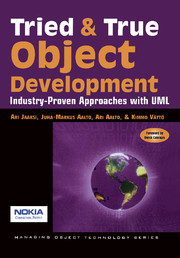Book contents
CHAPTER 4 - SMALL-SCALE DEVELOPMENT
Published online by Cambridge University Press: 06 July 2010
Summary
We have noticed that object-oriented software development methods tend to be too big and complex for small software projects. Large and complicated systems require that processes and tools scale up. However, not all projects need such massive arsenals, and therefore, practices must also scale down.
Need for a Streamlined Approach
Instead of detailed and complex modeling notations, many companies simply need a practical process, clear notation, and “how-to” guidelines. We argue that it does not really matter if the selected practices do not cover all details of object paradigm. Instead, the approach should first concentrate on covering the most important aspects of software development. Only after that can the details be handled.
To help you meet these requirements, we present a simplified process tailored especially for small teams implementing their first or second objectoriented application [Jaaksi 98a]. It is a streamlined version of our standard process model presented in Chapter 1.
The simplified process uses UML. It also uses our standard two-path approach, enabling developers to view systems as collaborative entities. The process is tailored especially for small companies with little knowledge on object-oriented software development. The use of the process requires that the architecture of the developed system is fairly simple, and consists of only a few separate run-time components. It suits especially well for the applications consisting of only one executable program implemented in an object-oriented language.
Overview of the Approach
Our simplified process supports three aspects of the system to be developed. First, the process models the external functionality of the system; that is, what the system provides to the end user.
- Type
- Chapter
- Information
- Tried and True Object DevelopmentIndustry-Proven Approaches with UML, pp. 263 - 282Publisher: Cambridge University PressPrint publication year: 1998

